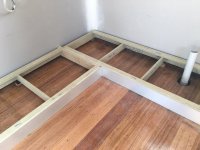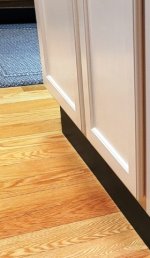I build a ladder base using the straightest Douglas fir members I can find, sizing each base to be 1" shorter on each end than the run of the cabinets (to allow for toekicks custom cut to cover and protect the end fir pieces), and 6" narrower (front-to-back) to accommodate irregularities in the wall run as well as to allow for a solid 5" deep toekick area (to accommodate a custom-cut toekick). I cut the width of the ladder base to make the finished countertops 36" AFF. If the cabinets are to be in an area where the floor is frequently wet, I cut the toekicks to sit 1/8" up off the finished floor to prevent water from soaking into the finished toekicks, and in some cases, I'll use Azek (vinyl) trim boards to be non-absorbent toekicks. All ladder bases are leveled using shims before being screwed down (I use pocket screws inside the base frame). Cabinets are screwed down to the ladder base crossmembers, and to wall studs and shimmed as needed to accommodate wandering walls, as [member=65062]DynaGlide[/member] mentioned.


